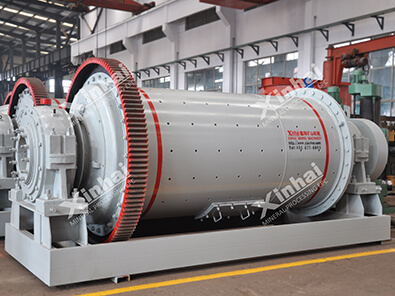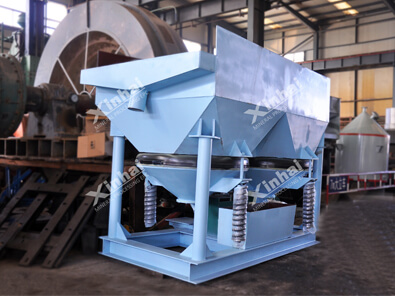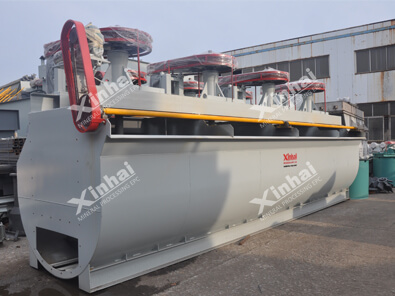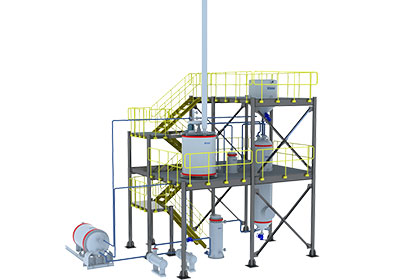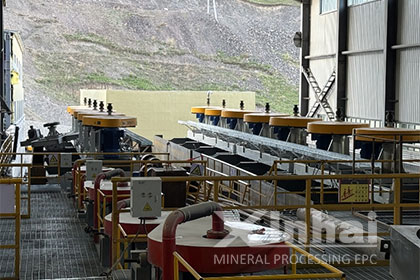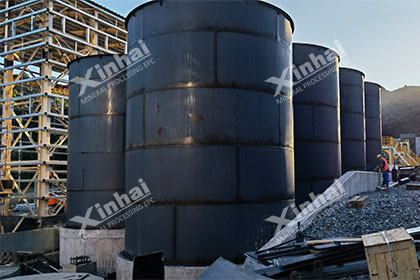The Complete Guide to Dolomite Beneficiation
 Laura
Laura
 Jan 24, 2024
Jan 24, 2024
 1365
1365
If you want to know more details about equipment, solutions, etc, please click the button below for free consultation, or leave your requirements!
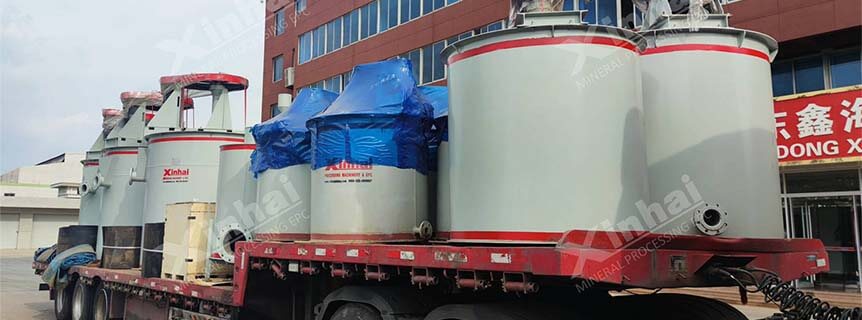
( Flotation equipment is loaded onto the truck )
Welcome to the complete guide to dolomite beneficiation. Dolomite, a mineral composed of calcium magnesium carbonate, is widely used in various industries due to its versatile properties. However, raw dolomite often requires beneficiation to improve its quality and enhance its suitability for specific applications. In this comprehensive guide, we will explore the world of dolomite beneficiation, covering its definition, processes, benefits, and applications. Whether you are a professional in the mining, construction, agriculture, or environmental sector, this guide will equip you with the knowledge and insights necessary to navigate the realm of dolomite beneficiation effectively.
01What is Dolomite?
BackDolomite is a sedimentary rock that primarily consists of calcium magnesium carbonate (CaMg(CO3)2). It is formed through the alteration of limestone or lime mud by magnesium-rich groundwater. Dolomite is often found in extensive beds, and its color can range from white to gray to pink, depending on impurities present in the rock. It has a distinctive crystal structure and is known for its hardness and rhombohedral cleavage. Dolomite deposits can be found all around the world and are commonly used as a source of magnesium and calcium.
02The Importance of Dolomite Beneficiation
BackRaw dolomite, as extracted from the earth, may not always possess the desired properties for specific applications. Beneficiation is the process of improving the quality and enhancing the properties of dolomite through various techniques. The primary objectives of dolomite beneficiation are to remove impurities, enhance purity, and optimize particle size and distribution. By undergoing beneficiation, dolomite can be transformed into a more valuable material suitable for a wide range of industries. The benefits of dolomite beneficiation include increased economic value, improved performance, and expanded application possibilities.
03Dolomite Beneficiation Techniques
BackDolomite beneficiation involves several techniques to improve its quality and suitability for various applications. The following are some commonly used techniques in dolomite beneficiation:
1. Crushing and Grinding
The first step in dolomite beneficiation is the crushing and grinding of the raw ore to the desired particle size. Crushing is typically done using jaw crushers, gyratory crushers, or impact crushers, while grinding is achieved through ball mills, rod mills, or other types of grinding equipment. The goal is to reduce the size of the dolomite ore to facilitate subsequent beneficiation processes.
2. Classification and Separation Methods
After crushing and grinding, dolomite beneficiation often involves classification and separation methods to separate the valuable dolomite from impurities. Techniques such as screening, hydrocyclones, and spiral classifiers are used to separate dolomite particles based on size and density. Magnetic separation can also be employed to remove magnetic impurities from dolomite ores.
3. Flotation and Chemical Processes
Flotation is a widely used technique in dolomite beneficiation. It involves the addition of flotation reagents to selectively separate dolomite from impurities. Froth flotation is commonly used, where air bubbles are introduced into a mixture of water, dolomite, and reagents. The dolomite particles attach to the air bubbles and rise to the surface, forming a froth layer that can be collected.
Chemical processes such as leaching, acid digestion, or solvent extraction can also be employed in dolomite beneficiation to remove impurities or enhance specific properties. These processes involve the use of chemicals to dissolve or extract impurities, leaving behind purified dolomite.
4. Calcination and Sintering
Sintering involves heating the calcined dolomite at high temperatures, typically between 1100°C and 1350°C, to form agglomerates or pellets. This process further enhances the reactivity and strength of the dolomite, making it suitable for applications such as iron and steel production.
5. Drying and Agglomeration
Drying is an essential step in dolomite beneficiation to remove moisture and prepare the material for subsequent processing or transportation. Various drying techniques, such as rotary dryers or fluidized bed dryers, can be used depending on the specific requirements.
Agglomeration is another process used in dolomite beneficiation to improve handling and processing characteristics. By agglomerating dolomite fines or powders into larger particles or granules, their flowability, dispersibility, and bulk density can be enhanced.
04Applications of Dolomite Beneficiation
BackDolomite, after undergoing beneficiation, finds applications across various industries. Some of the key applications include:
1. Agriculture and Soil Amendment
Beneficiated dolomite is commonly used as a soil amendment to correct soil acidity (pH) and provide essential nutrients like calcium and magnesium. It helps improve soil structure, enhance water retention, and promote healthy plant growth.
2. Construction Materials and Aggregates
Dolomite is utilized in the construction industry as a source of aggregate for concrete and asphalt mixtures. It provides durability, strength, and resistance to wear and weathering in various construction applications like roads, buildings, and bridges.
3. Iron and Steel Production
Calcined dolomite is used in iron and steel production as a fluxing agent, which helps remove impurities and improve the quality of the final product. It aids in the removal of sulfur and phosphorus during the steelmaking process and enhances the fluidity of molten metal.
4. Glass and Ceramics Manufacturing
Dolomite is a vital ingredient in the production of glass and ceramics. It acts as a flux, helping to lower the melting point of the raw materials and improve the transparency and chemical resistance of glass. In ceramics, dolomite provides strength, durability, and thermal shock resistance.
5. Environmental Remediation and Water Treatment
Beneficiated dolomite is used in environmental remediation projects, particularly in neutralizing acidic mine drainage and treating contaminated water. Its alkaline properties help raise the pH and neutralize harmful acidic substances, making it valuable for water treatment processes.
6. Pharmaceutical and Chemical Industries
Dolomite finds applications in the pharmaceutical and chemical industries as a source of magnesium and calcium salts. These salts are used in the production of medicines, dietary supplements, antacids, and various chemical formulations.
05Factors Affecting Dolomite Beneficiation
BackSeveral factors influence the success of dolomite beneficiation processes. These factors include:
1. Quality and Characteristics of Dolomite Ores
The quality and characteristics of dolomite ores, such as purity, composition, hardness, and particle size distribution, significantly impact the beneficiation process. Understanding these properties helps in selecting appropriate beneficiation techniques and optimizing process parameters.
2. Process Variables and Optimization
Optimizing process variables such as temperature, residence time, reagent dosage, and pH levels can improve the efficiency and effectiveness of dolomite beneficiation. Continuous monitoring, analysis, and adjustment of these variables are crucial for achieving desired outcomes.
3. Equipment Selection and Operation Considerations
Choosing the right equipment for each beneficiation process is vital. Factors such as capacity, efficiency, energy consumption, maintenance requirements, and cost should be considered when selecting and operating equipment for dolomite beneficiation.
06Best Practices for Dolomite Beneficiation
BackTo ensure successful dolomite beneficiation, certain best practices should be followed, including:
1. Quality Control and Assurance Measures
Implementing robust quality control and assurance measures throughout the beneficiation process is essential. Regular sampling, testing, and analysis of dolomite samples help monitor and maintain product quality and consistency.
2. Environmental and Safety Considerations
Adhering to environmental and safety regulations is crucial during dolomite beneficiation. Proper waste management, emissions control, and worker safety protocols should be in place to minimize any adverse impact on the environment and ensure the well-being of personnel.
3. Cost Optimization Strategies
Developing cost optimization strategies can help maximize the economic value of dolomite beneficiation. This includes efficient use of resources, energy-saving measures, waste reduction, and exploring opportunities for byproduct utilization.
07Future Trends and Innovations
BackThe field of dolomite beneficiation is continually evolving with advancements in technology and research. Keeping an eye on future trends and innovations, such as novel beneficiation techniques and sustainable practices, is important. Some potential future trends in dolomite beneficiation include:
1. Advanced Separation Techniques
Researchers are exploring innovative separation techniques that can improve the efficiency and selectivity of dolomite beneficiation. These techniques may involve the use of advanced flotation reagents, magnetic separation technologies, or novel classification methods.
2. Green Beneficiation Practices
With a growing emphasis on sustainability, there is a push towards developing greener beneficiation processes for dolomite. This includes reducing energy consumption, minimizing water usage, and exploring environmentally friendly reagents and waste management practices.
3. Process Automation and Digitalization
Automation and digitalization are transforming various industries, and dolomite beneficiation is no exception. The integration of advanced process control systems, real-time monitoring, and data analytics can optimize operations, improve efficiency, and reduce costs.
4. Byproduct Recovery and Utilization
Dolomite beneficiation processes often generate byproducts or waste streams. Future trends may focus on exploring opportunities for recovering and utilizing these byproducts in other industries or applications, thereby maximizing resource utilization and minimizing waste.
08Conclusion
BackDolomite beneficiation plays a crucial role in enhancing the value and applicability of this versatile mineral. By undergoing beneficiation processes such as crushing, grinding, classification, flotation, and calcination, raw dolomite can be transformed into a high-quality material suitable for various industries. The applications of beneficiated dolomite are diverse, ranging from agriculture and construction to iron and steel production, glass manufacturing, and environmental remediation.
Successful dolomite beneficiation requires careful consideration of factors such as ore quality, process variables, equipment selection, and environmental and safety considerations. By following best practices, implementing quality control measures, and staying updated with future trends and innovations, the field of dolomite beneficiation can continue to evolve and contribute to sustainable development.
Contact us to get more information and solutions!
 +86 183 3575 8886
+86 183 3575 8886 pinklaurabao@gmail.com
pinklaurabao@gmail.com




 Message
Message Chat Now
Chat Now


